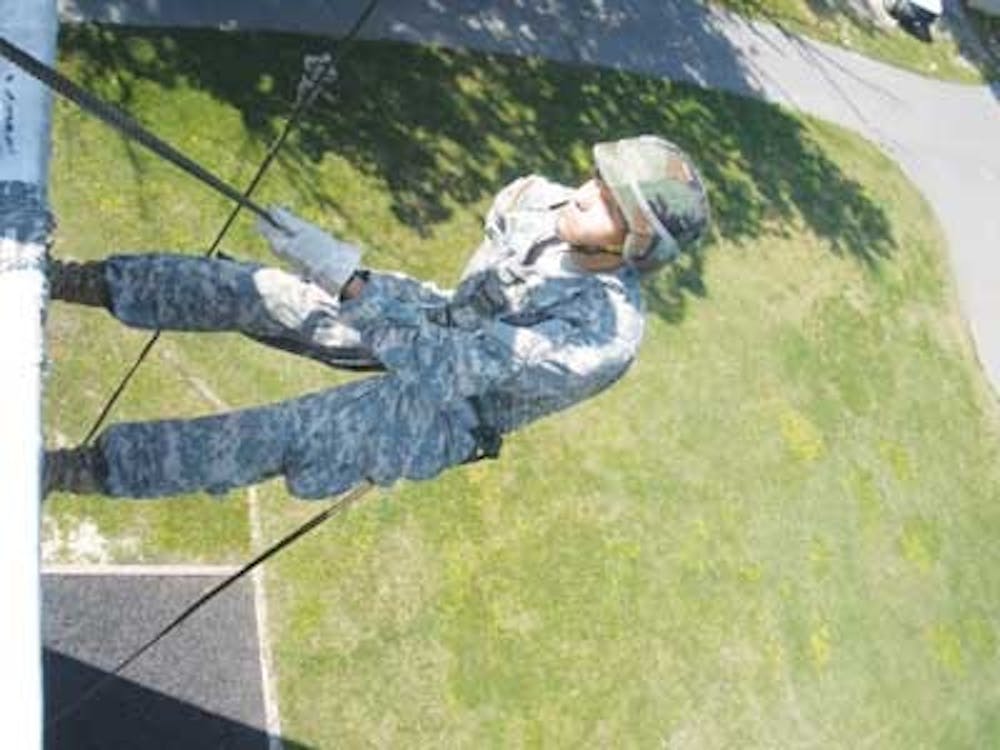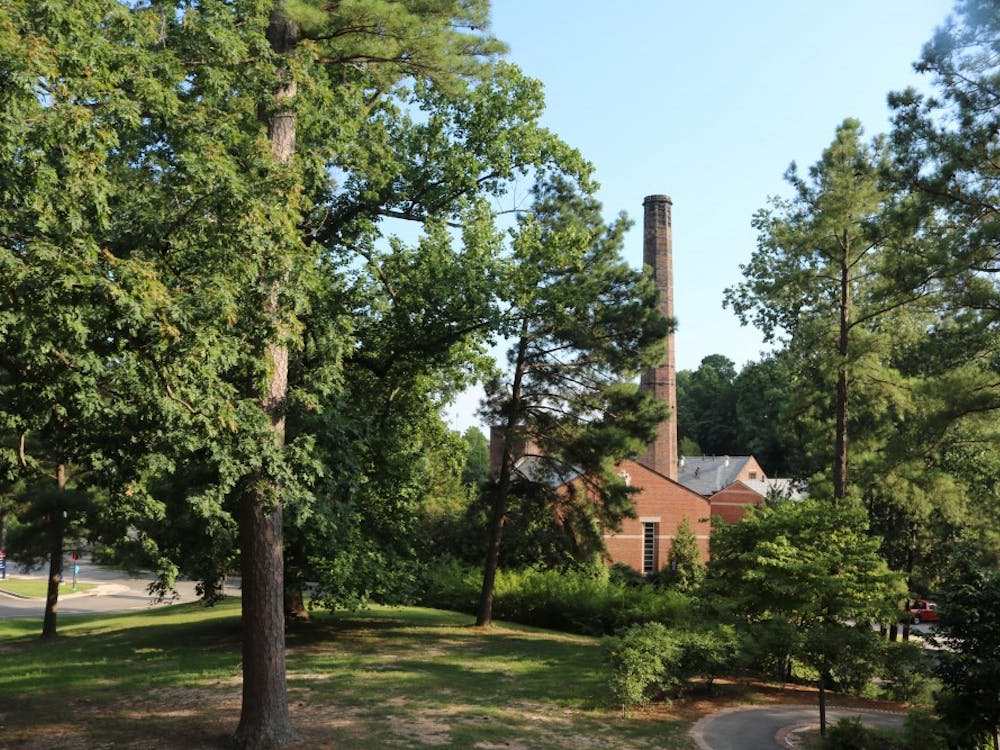Collegian Reporter
As the sun rises on Fraternity Row, a line of ROTC cadets stand symmetrically, hands folded behind their backs, waiting for the transport to Fort Lee for their first overnight training program of the year. They are talking about new types of Kevlar.
"I saw it online for 200 bucks," says one.
"They had it at the surplus store, too," says another. "It's a lot less heavy. Easier to carry."
Sgt. Richard DeLeon walks through the rows, checking that each cadet's canteen is full. Water's important. It's going to be a hot one today.
The Category-2 hurricane that was supposed to come didn't. In its place will be a 94-degree sun bearing down on the cadets and their layered fatigues. DeLeon explains how to properly ventilate through their thick undershirts and heavy Army Combat Uniforms. They have to wear them all day, along with a 35-pound backpack that contains everything they need to survive for two days: sleeping gear, pads, ponchos, and ready-to-eat meals among other necessities. That's not counting the Kevlar.
The cadets were on their way to this weekend's Reserve Officers' Training Corps Leadership Lab in Fort Lee, Va. It's an overnight affair that began around 4 a.m. Saturday, and will extend until late the next day. On the agenda was rappel training, movement techniques, weapons familiarization, land navigation and many other activities.
University of Richmond ROTC cadets go to Fort Lee every fall for this exercise. There are three more weekend trips lined up for the rest of the year. Alongside Richmond, Hampden-Sydney College, Randolph-Macon College, Longwood University and Virginia Commonwealth University ROTC programs were all present last weekend. The five colleges were be broken up and mixed together into groups composed of cadets from each year.
Out of the 68 cadets attending, 15 were first-years. This was their first excursion with the ROTC -- their first test. The 14 seniors present, too, were tested last weekend. They were in charge of running the whole show -- scheduling events, shuttling cadets, procuring gear, assessing risk and measuring safety precautions. On the cusp of graduation, this was their first test of officership. This is the next generation of U.S. soldiers. They are the ones who will soon inherit the growing climate of unrest in today's global theater. Each of them will soon represent this country abroad more than any politician or ambassador could ever aspire to. They know how important their duty is, and they look ready.
Enjoy what you're reading?
Signup for our newsletter
0800 hours: Rappelling. Guns N' Roses roared through the speakers of a nearby ROTC van while Lt. Col. Gillem demonstrated proper rappelling technique to a crowd of cadets. Gillem is the man in charge here, a man with plenty of previous combat tours under his belt, a man revered by these students.
The cadets stared upwards at the flat, unforgiving wall. It's 50 feet high -- getting to the top requires trudging up five flights of stairs, each one a little more daunting, each one bringing you closer to the windy peak. Many of the younger cadets had never seen a rappel wall that high. It cast a long shadow that cut into the otherwise sun-drenched field.
Leaning backward over the ledge, Gillem shot down the side with a zip and a snap. At the bottom, he released his carabineer and the square knot tied around his waist -- the sole source of support for this dangling high-wire act.
"Everybody goes up the wall, everybody goes down," Gillem shouted to the crowd of cadets.
Dansby Skinner is a second-year student at VCU. He was in Fort Lee as a prospective ROTC cadet. This was his first time at the Leadership Lab, and his first time on the rappel wall.
"Just don't look down," Skinner said to the rest of the prospective cadets in his group. There were seven in total, students getting their first taste of the strenuous ROTC life.
The group shot down the wire same as Gillem, kicking off the flat brown wall with a dose of adrenaline and heavy breathing. The knots they depend on to get down were tied with their own hands, with the help of a few seasoned rappel trainers. It's called a Swiss Seat, and it can give some serious rope burn.
And finally back on Earth, before the cadets can even catch their breath they were once again lined up and marched away from the sky-scraping rappel wall. There's much more to be done. It was still early.
0930 hours: Individual Movement Techniques. The senior cadets in charge led each group down a dusty dirt road, through rocks and trees and into the forest canopy. It was getting hotter.
Here in the woods is where the cadets would get down and dirty, they'll be taught to crawl -- crawl low -- digging through the woodland underbelly with a teammate while avoiding paintball fire from up ahead. They would learn to place claymore explosive devices with appropriate caution, and extract themselves from a hostile fire situation quickly and safely. For those cadets looking to do active combat duty after graduation, this would be the most relevant hands-on training they would receive all day.
Riannon Blaisdell-Black is a senior ROTC cadet at the University of Richmond. For the better part of the past month, she had been working long, demanding hours trying to bring this whole weekend together. A walkie-talkie at her side constantly buzzed with updates from other senior cadets around the 20-acre camp. She carried a thick binder full of tables, matrices, diagrams and maps.
"It's neat to see it all come together," Blaisdell-Black said.
Along with weekend excursions such as this one, Richmond ROTC cadets are required to attend physical training every Tuesday and Thursday at 6 a.m., with a Military Science and Leadership class right afterwards. There they learn troop-leading procedures, how to conduct battle drills and develop Army values.
For a senior cadet, attempting to balance all these ROTC responsibilities with a full college course load is a tightrope act.
"It's hard," Blaisdell-Black said. "You have to sacrifice. This has been my life for the past few weeks."
But it's all worth it to her. Soon Blaisdell-Black will receive orders regarding which military branch she'll enter upon graduation. She's hoping for either intelligence or military police.
"When you're an MP you get to use a lot of guns," she said.
But Blaisdell-Black and the other senior cadets still have a lot of work to do before then. They're in charge of planning the next weekend outing in mid-November, too, as well as two more during the spring. It is this challenging, exacting nature that drives her devotion to ROTC.
"That's what drew me in," Blaisdell-Black said. "All these unique training events in the woods that you'd never get to do normally in college. It's pretty high-speed."
1400 hours: Marksmanship and Weapons Familiarization. Years of military technological research and millions of dollars have led here: the electronic weapons range. It's a small building sitting in the middle of the field. Inside was a wide projection screen that simulates a long target range. Across from it were four electronic assault rifles constructed to be replicas of their lethal counterparts. They're heavy, made of steel, and give accurate kickback with each pull of the trigger.
"It's basically a $7 million game of 'Duck Hunt,'" one cadet said.
This would be the last exercise of the day for the group of prospective ROTC candidates. The rest of the cadets would stay overnight, sleeping outside, persevering for another day.
Steven Willard, another second-year prospective cadet from VCU, was glad he came.
"I feel I've got a duty to serve, so that's why I'm here," he said.
Willard is studying urban planning in school and aspires to one day become an architect. The army, he said, will help him realize that aspiration. He hopes to be assigned to military engineering after graduation. There, working in the field of combat construction, he'll learn how to build advanced structures under extreme time constraints, possibly even in war zones.
"The ROTC will give me a chance to do what I really want to do," Willard said. "It could be a career."
ROTC cadets are required to give back six to eight years of military service upon graduation. For many, a chance of being an officer is what they've been waiting for their entire lives.
"An army officer is the most respected profession in the United States," Lieutenant Colonel Gillem said, addressing the prospective cadets before their departure. "And I'm glad you were here with us today."
It had been a long day in Fort Lee, and it wasn't even finished yet for most of the cadets. But for the group of seven prospectives, it was time to dust off and turn in the Kevlar. On the ride back into Richmond, they talked about the experience -- the paintball drills, the weapons range, and of course, the rappel wall.
"I was so into it, I just wanted to get up there and do it, make it work," Dansby Skinner said. "So I did it."
Contact Collegian reporter Michael Gaynor at michael.gaynor@richmond.edu
Support independent student media
You can make a tax-deductible donation by clicking the button below, which takes you to our secure PayPal account. The page is set up to receive contributions in whatever amount you designate. We look forward to using the money we raise to further our mission of providing honest and accurate information to students, faculty, staff, alumni and others in the general public.
Donate Now



